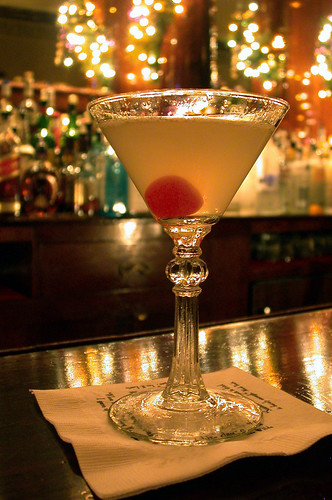Blood and Sand
This one came to my attention in one of Gary Regan’s columns, where the Professor and Doc sample a 1930 classic. It was named after a 1920s Rudolph Valentino movie, based on a novel of the same title by Vincente Blasco Ibáñez. It has since become one of my favorite Scotch-based cocktails (and that’s not all …).
Blood and Sand
3/4 ounce blended Scotch.
3/4 ounce sweet vermouth.
3/4 ounce Cherry Heering.
3/4 ounce fresh orange juice.Shake with cracked ice and strain into chilled cocktail glass.
The smokiness of the Scotch works well in harmony with the other ingredients here, as unlikely as that may sound. If you want to take it to another level, swap out the Scotch for a good smoky mezcal, such as one of the Del Maguey offerings, or perhaps Sombra if you want to crank the smoke level up even more. With this substitution, though, you should call it an Arena y Sangre.
[UPDATE] The above photo was taken at the 2007 Spirited Dinner at Commander’s Palace at Tales of the Cocktail in New Orleans, in which Chef Tory McPhail’s dishes were paired with cocktails by Audrey Saunders and Dale DeGroff. The Blood and Sand is a classic cocktail, and the only straight-ahead classic that was served at the meal. Usually it calls for a blended Scotch, and though I’m not sure what Scotch they used in this one, it did have a bit of smoke it it, which made it so perfect to go along with what was to come. Let’s talk cocktail pairings with food … here’s the dish that this drink accompanied.
Our entrée was Sugarcane and Bourbon Smoked Duck, smoked over smoldering whiskey barrels with local figs, a sweet potato pone, BBQ’ed onions, vanilla bourbon syrup and foie gras ganache.
Jesus Gawd.
Let’s just go through this again, shall we? Duck with Bourbon and sugarcane rub, smoked over smoldering wood from whiskey barrels. This is one reason why Tory McPhail is one of my favorite people on the planet. This dish was just fantastic; I think Wes and I had our eyes rolled up in our heads more than once while eating this dish. And the really fascinating thing is that the booze in the dish wasn’t paired with the booze in the drink this time … the smoke in the booze in the drink was paired with the smoke in the duck in the dish.
THAT, my friends, is how you pair a cocktail with a dish.
I wanted thirds and fourths of this, and I’m going to cry next time I go to Commander’s because this dish won’t be on the menu. Maybe I’ll luck out and it will, though. Fingers crossed.








